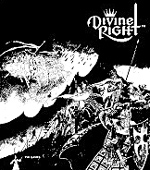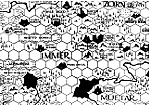 TSR (1979, $10.00)
TSR (1979, $10.00)
Designers: Glenn & Kenneth Rahman
Players: 2-6
Playing Time: 2-4 hours
Period: Fantasy
Scale: Strategic
- Turn: not stated
Map: hexes, scale not stated
Unit: Army or Fleet
Box: 11”x9” thin bookcase box
Components:
22”x34” unmounted map sheet, 20 page rulebook with two perforated pull-out reference sheets (2nd edition), 280 die-cut counters, 4 sheets of identity and personality cards, sheet of diplomacy cards, and 2 six-sided dice.
Card manifest:
36 large cards (14 identity cards, 20 personality cards, 2 blanks) and 45 small diplomacy cards.
Counter manifest:
It should be noted that both the first and second editions have many blank counters (at least two dozen or more). The exact counts could not be verified prior to publication.
TSR says:
“[C]ombines combat, diplomacy, and role-playing ... as each player attempts to build and hold together an alliance of kings long enough to defeat the other players and win the game. The kingdoms of humans, elves, goblins, dwarves and trolls are pawns in the power games that absolute monarchs play. Ambassadors vie for the attention of the kings whose favor they curry. Assassination and backstabbing are popular pastimes, and loyal allies may leave your side in the heat of battle at the drop of a hat ... The magicians, too, get their arcane fingers into things, and the gods intervene as they will.”
The reviewers say:
“A fantasy board game a bit out of the usual mold. While there is some magic in it, it is essentially a game of military and political strategy. Thirteen states are represented on a mythical continent, and one of them is assigned to [each player] at random. Each of the players is ‘on the board’ in the form of a monarch piece, which, if killed or captured, knocks the player out of the game ... Play is fast moving, as usually few units are in play and lengthy discussions between players are not as important as in other multi-player games.” Steve List in Ares 1.
“Overall, this is an excellent game; no two play sessions are alike. The challenge of playing a different kingdom keeps players thinking, and the variety of special units can alter events quickly. It will be a long time before players grow bored with Divine Right; I give it my highest recommendation.” Doug Traversa in The Space Gamer 29.
“There are, included among the components of the game, a deck of personality cards that are applied to the non-player monarchs. As a non-player monarch is contacted and an attempt is made to win him over, you select, at random, a personality card ... with 20 cards, and far fewer monarchs, one can immediately see the possibilities of endless scenarios never duplicating previous ones, as well as a constantly changing face of the game as a given monarch is killed or is replaced, and a new one replaces him with a new personality. The political face of the game can shift, radically, with the death of a non-player monarch, and his replacement with a new personality.” Tim Kask, early Divine Right playtester, in The Dragon 28.
 Comments: The first time I saw a friend’s copy of Divine Right a little over 15 years ago, my reaction was “wow”. The first time we played it with six players, my reaction was “WOW!” Unlike many other games which prove that nostalgia is wrong more often than not,
Divine Right still delivers a high quality gaming experience today. There are a number of reasons that Divine Right has held up over the years. It was a game you could set up and just start playing. The random assignment of starting kingdoms had the effect of making each game feel somewhat like a new scenario. The variety of units presented different strategies and options for each kingdom. And most importantly,
the game has a fantasy world overflowing with depth and character.
Comments: The first time I saw a friend’s copy of Divine Right a little over 15 years ago, my reaction was “wow”. The first time we played it with six players, my reaction was “WOW!” Unlike many other games which prove that nostalgia is wrong more often than not,
Divine Right still delivers a high quality gaming experience today. There are a number of reasons that Divine Right has held up over the years. It was a game you could set up and just start playing. The random assignment of starting kingdoms had the effect of making each game feel somewhat like a new scenario. The variety of units presented different strategies and options for each kingdom. And most importantly,
the game has a fantasy world overflowing with depth and character.
While there are other fantasy wargames that present a fictional world as vividly as Divine Right, I don’t think there are any that do it in as clean and straightforward a manner. Tom Wham’s assessment sums it up: “a game on the order of SPI’s War of the Ring and Chaosium’s White Bear and Red Moon ... only better.”
Collector’s Notes:
In 1997 I learned that there were plans to publish a new edition of Divine Right and an expansion cum sequel called Scarlet Empire. Unfortunately neither project has reached publication. Until a new printing materializes, be prepared to pay dearly to acquire a copy. Boone lists low/high/ average prices of 40/155/79.82 at auction and 15/150/81.88 for sale.
Literature:
Divine Right received a great deal of attention in TSR’s Dragon magazine. The most notable issues were 34 and 46. Issue 34 contains a treasure trove for Divine Right fans - official second edition rules, changes from the designer, ambassador personality cards, siege engine rules/counters, and several other variant rules. Issue 46 featured six variants from the designer. Finally, you can find the designers’ notes in issue 27. Designer Glenn Rahman also wrote a series of Minarian Legends articles detailing the fictional history of the countries and personalities featured in the game. These articles appeared in The Dragon issues 34-39, 41-42, 44-46, 48-52, and 54-57. The good news is that all of the articles and variants are available for one low price on The Dragon Magazine CD-ROM Archive, a digital collection of the first 250 issues of The Dragon.
Other designs by the Rahmans:
Down With the King (AH) and Knights of Camelot (TSR). Individually, Glenn: The Trojan War (Metagaming) and Kenneth: Dark Cults (Dark House).
Back to Simulacrum Vol. 2 No. 3 Table of Contents
Back to Simulacrum List of Issues
Back to MagWeb Master Magazine List
© Copyright 2000 by Steambubble Graphics
This article appears in MagWeb (Magazine Web) on the Internet World Wide Web. Other military history articles and gaming articles are available at http://www.magweb.com